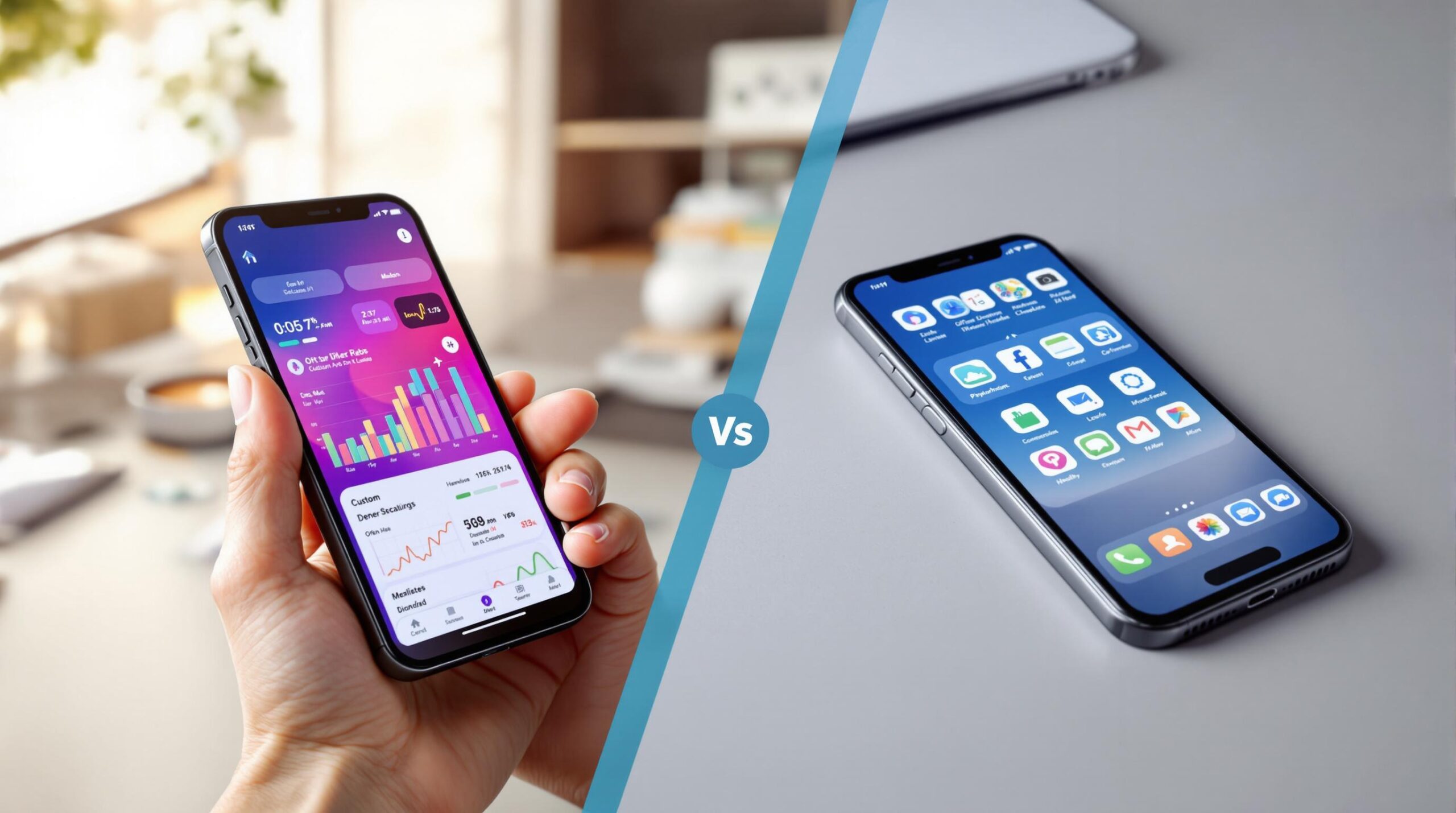
Custom mobile apps and off-the-shelf IoT solutions each have distinct advantages and drawbacks. Here’s a quick comparison to help you decide:
- Custom Mobile Apps: Tailored to specific needs, offering full control over integration, scalability, security, and compliance. Higher upfront costs but better for long-term growth and specialized workflows.
- Off-the-Shelf Solutions: Pre-built, cost-effective, and quick to deploy. Limited customization, scalability, and security features. Best for general use or small budgets.
Quick Comparison:
| Aspect | Custom Mobile Apps | Off-the-Shelf Solutions |
|---|---|---|
| Development | Built for unique needs | Pre-made, general features |
| Integration | Seamless with existing systems | Limited compatibility |
| Scalability | Easily adaptable for growth | Restricted by platform limits |
| Security | Custom privacy tools | Basic security measures |
| Cost | Higher upfront, lower long-term | Lower upfront, ongoing fees |
| Compliance | Tailored for regulations | Basic compliance options |
| Deployment Time | 2+ years for complex systems | Ready to use immediately |
Choose custom solutions for specialized industries like healthcare, where security, compliance, and scalability are critical. Off-the-shelf options work well for quick, budget-friendly implementations in less regulated environments.
Custom vs. Off-the-Shelf IoT Solutions
What Are Custom and Off-the-Shelf IoT Solutions?
When deciding between custom mobile apps and off-the-shelf solutions for IoT needs, it’s important to weigh factors like development, integration, scalability, and security.
Custom Mobile Apps: Tailored to Your Needs
Custom IoT apps are designed from the ground up to fit specific workflows and integrate seamlessly with existing systems. They offer robust control over features, protocols, and analytics, ensuring alignment with your organization’s processes . These apps also allow for future growth, with the flexibility to adapt and expand as your needs evolve . They work well with legacy systems, databases, and specialized tools like ERP or CRM software, making them an excellent choice for industries like healthcare or research.
| Aspect | Features of Custom Mobile Apps |
|---|---|
| Development | Designed specifically for unique needs |
| Integration | Fully compatible with current systems |
| Scalability | Easily adjusted as requirements grow |
| Security | Customized privacy and security tools |
| Long-term Cost | More economical over time |
Off-the-Shelf Solutions: Quick and Standardized
Off-the-shelf IoT solutions come pre-built and ready for immediate use. They are often more budget-friendly upfront but offer limited customization and integration options . These platforms are designed with standard features and basic protocols, which may not fully meet the needs of specialized workflows or industries .
While these solutions are great for quick deployment, they lack the flexibility to adapt to unique requirements or long-term growth . This is especially important for regulated fields like healthcare, where compliance and tailored features are critical.
| Aspect | Features of Off-the-Shelf Solutions |
|---|---|
| Development | Pre-made with general features |
| Integration | Limited compatibility with systems |
| Scalability | Restricted by platform limitations |
| Security | Basic security measures |
| Initial Cost | Lower upfront expense |
How to Choose Between Custom and Pre-Built Solutions
Flexibility and Growth Options
Custom IoT solutions can evolve alongside your needs. For example, Rayven‘s platform started by monitoring equipment efficiency in manufacturing but later expanded to include predictive maintenance and energy management across facilities. This showcases how custom solutions can grow with your business .
As businesses scale, they require solutions that can handle more devices, higher data traffic, and added features. Custom solutions make it easier to integrate new technologies and respond to market changes. In contrast, off-the-shelf platforms often face scaling limits, which can lead to additional costs down the line .
Now, let’s look at how integration and security play a role in this decision.
System Connection and Data Protection
Custom IoT applications give you complete control over access, personnel, and data storage. This is especially important in fields like healthcare and research .
"When you’re in the custom domain, you have the advantage of having full control over how security is implemented both from access controls and personnel, and where data is stored." – Twisthink
Off-the-shelf solutions, however, often struggle with compatibility issues and may not offer advanced security features. They also frequently rely on third-party data storage, which can introduce extra security risks .
Budget Impact
Cost is another critical factor. Here’s a breakdown of typical costs for different IoT solutions:
| Solution Type | Initial Investment | Examples of Real Costs |
|---|---|---|
| Custom Healthcare Apps | Higher upfront cost | ECG tracker: $300,000 |
| IoT Security Systems | Variable | Smart home system with facial recognition: $5M |
| Specialized Applications | Medium range | Hospital staff alert system: $10,000-15,000 |
| Compliance Certification | Fixed cost | Electronic device certification: Starting at $10,000 |
While pre-built solutions may seem cheaper initially, they often come with ongoing costs like licensing fees and subscriptions . Custom solutions, on the other hand, offer better long-term cost control, especially for cloud and piece costs. However, they do require a dedicated team for support .
Meeting Industry Rules
Industry regulations are a major consideration when choosing between custom and pre-built solutions. Custom IoT applications can be designed to meet strict compliance standards like HIPAA by tailoring security protocols and data handling processes .
Pre-built solutions might offer basic compliance features, but they often fall short when it comes to addressing complex regulatory needs. This can be a significant drawback in industries like healthcare and research, where data privacy and security are critical .
sbb-itb-7af2948
Benefits and Drawbacks Comparison
Healthcare organizations are dealing with a sharp rise in cybersecurity threats – data breaches jumped 53% between Q1 2023 and Q1 2024 . At the same time, IoT solutions come with their own set of pros and cons. The table below breaks down these trade-offs across key factors.
"Custom IoT solutions create a strategic barrier by providing capabilities off-the-shelf options cannot" .
Side-by-Side Comparison
| Aspect | Custom Mobile Apps | Off-the-Shelf Solutions |
|---|---|---|
| Security | Full control over implementation and data storage; quick vulnerability fixes | Limited control; vendor-dependent; 53% of IoT medical devices face critical threats |
| Scalability | Adapts to growth and new technologies | Restricted by platform limitations |
| Development | Requires 2+ years with a dedicated team | Ready for immediate use |
| Cost | Higher upfront costs but better long-term control | Lower initial costs; ongoing subscription fees |
| Performance | Optimized for specific tasks | General-purpose functionality |
| Compliance | Includes built-in HIPAA, GDPR, and CCPA protocols | Limited ability to adapt to regulations |
| Integration | Unified communication standards | Limited compatibility options |
| Maintenance | Direct control over updates | Support depends on the vendor |
Cyberattacks targeting healthcare IoT devices surged by 74% between 2021 and 2022, with an average of 1,463 attacks per week .
The cost-benefit analysis sheds more light:
"Off-the-shelf mobile apps are generally more affordable than custom-built solutions because they are developed for mass use. This makes them a good option for small businesses or startups with limited budgets" .
To achieve top performance, your IoT setup will need dependable sensors and a system designed for fast data processing . These comparisons outline the key considerations for choosing the right IoT solution.
Healthcare IoT Case Studies
Examples of IoT use in healthcare highlight the differences between tailored solutions and ready-made options. With 83% of U.S. hospitals now using electronic records, making the right IoT choice is more important than ever .
Medical Device Apps
Custom applications often outperform pre-built solutions in specialized healthcare scenarios. For instance, Itransition created a HIPAA-compliant mobile teleconference app for rural healthcare. This tool allowed nurses to assist assault victims remotely while collecting evidence, speeding up case creation by three times .
Custom apps can connect with proprietary imaging devices, enable real-time tracking via wearables, and ensure data security through advanced encryption . McKinsey & Company reports that 50% of healthcare organizations have adopted machine learning algorithms, emphasizing the need for tailored solutions to handle complex data .
In comparison, off-the-shelf platforms often fail to meet the demands of these specialized situations.
Standard IoT Platforms in Studies
Pre-built platforms frequently fall short when it comes to the unique needs of healthcare organizations . For example, Itransition developed a custom cross-platform mobile app to enhance an existing healthcare system for adverse event reporting. The result? A 100% increase in submitted reports compared to the previous generic platform .
Additionally, nearly 90% of healthcare organizations using generic platforms reported data breaches in the past two years, with financial losses reaching $6.2 billion .
For research institutions, the decision between custom and off-the-shelf solutions often revolves around scalability and compliance. While custom solutions may start at $10,000 , they provide better integration with research protocols, adapt to changing regulations, enhance data security, and scale to meet expanding research needs .
These examples highlight trends in IoT use, particularly in areas like scalability and security. While off-the-shelf solutions might address basic needs, custom apps offer the precision, security, and compliance that healthcare demands.
Making Your Decision
Your choice should align with your organization’s specific needs and long-term objectives. According to recent data, 41% of users express dissatisfaction with off-the-shelf solutions due to limited customization and scalability . This highlights the importance of carefully evaluating your options.
In the healthcare industry, unique challenges arise, with 98% of organizations citing concerns about mobile solution implementation – especially when it comes to security and compliance .
Decision Checklist
When weighing your options, keep these key factors in mind:
| Decision Factor | Custom Solutions | Off-the-Shelf Solutions |
|---|---|---|
| Initial Investment | Higher upfront costs | Lower initial costs |
| Implementation Timeline | Can take up to 2 years for complex systems | Quick to deploy |
| Data Control | Full ownership and control | Security managed by the vendor |
| Scalability | Tailored to support growth | Limited by the vendor’s features |
| Compliance | Designed for specific regulations | Pre-built compliance options |
These points can help you identify the best option for your infrastructure. For healthcare applications, these factors become even more critical.
If your organization lacks an in-house development team, off-the-shelf solutions might be a better fit . On the other hand, custom solutions provide complete control over security but require internal expertise .
The return on investment (ROI) can be impressive: 78% of healthcare organizations report benefits from mobile apps, and 60% of high-growth companies prefer custom development . For those managing sensitive data or needing specific integrations, custom solutions often offer strategic advantages. This is particularly important for healthcare, where 82% of organizations have fully implemented mobile strategies .
In some cases, a hybrid approach – combining custom and off-the-shelf elements – might strike the right balance between immediate needs and future scalability . These considerations can guide your next steps in aligning IoT solutions with your operational goals.

